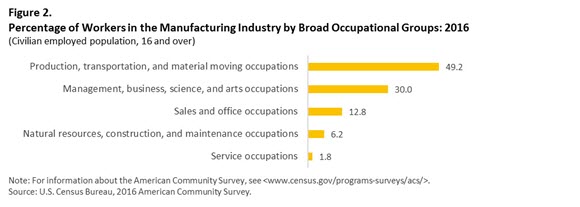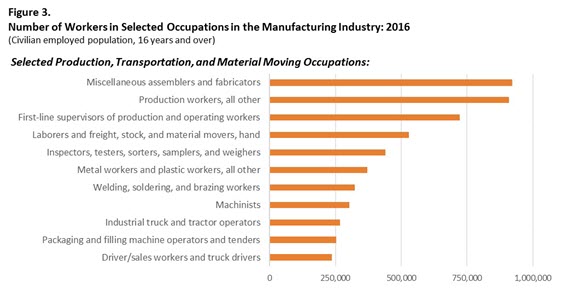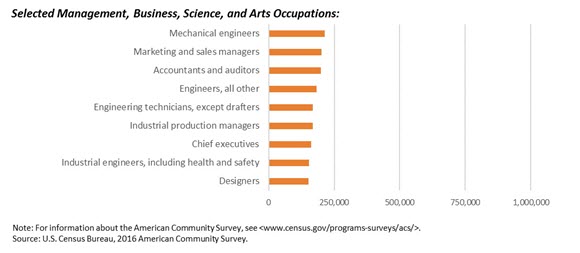Beyond the Products: A Look at the Workers and Their Occupations in the Manufacturing Industry
Beyond the Products: A Look at the Workers and Their Occupations in the Manufacturing Industry
One in 10, or 15.4 million, U.S. workers in the civilian workforce had jobs in the manufacturing industry in 2016, making everything from cars to food. What do we know about people who work in manufacturing? What specific occupations do manufacturing workers hold? Using the American Community Survey, we can paint a statistical picture of manufacturing workers to gain a deeper understanding of the people who work in the manufacturing industry.
Compared with all workers, people who work in the manufacturing industry were older, had less education, were mostly men, were more likely to work full-time, year-round, and earned more on average (see Figure 1).
Manufacturing industry employees work in hundreds of occupations, which can be organized into five broad groups. Almost half of workers were in production, transportation, and material moving occupations (49.2 percent) while management, business, science, and arts occupations comprised 30.0 percent. Other jobs within the manufacturing industry include sales and office occupations; natural resources, construction, and maintenance occupations; and service occupations (see Figure 2).
So let’s look at more specific types of jobs found within the manufacturing industry.
Within the broader category of production, transportation, and material moving occupations, some conventional occupations are miscellaneous assemblers and fabricators; laborers and freight, stock, and material movers, hand; inspectors, testers, sorters, samplers, and weighers; and metal workers and plastic workers, all other (Figure 3). In these occupations, according to the Standard Occupation Classification Manual, workers use their hands and operate machinery to move, transport, create or test a product. Welding, soldering and brazing workers operate machines; or by hand, they weld, braze or treat heating metal products. Machinists set up and operate machine tools that produce precision parts and instruments, and repair and modify mechanical instruments. Miscellaneous assemblers and fabricators and production workers, all other, work by hand or operate machines to create a large variety of products. Finally, 721,000 first-line supervisors of production and operation workers directly oversee and coordinate activities of personnel including machine setters and operators, assemblers, fabricators and system operators.
Engineers play an important role in the manufacturing industry (Figure 3). Mechanical engineers plan and design engines and machines. Industrial engineers, including health and safety specialists, design, develop and test systems to manage the industrial production process including quality control, human work factors and production coordination. In addition to engineers, approximately 170,000 technicians work in several fields of engineering under the direction of engineering staff or physical scientists.
Management jobs in the manufacturing industry are common (Figure 3). Marketing and sales managers plan, coordinate and direct marketing programs such as assessing the demand for a product or the distribution of a service or product to the customer. Industrial production managers plan, direct or coordinate resources and work activities needed for manufacturing, taking into account cost, quality and quantity specifications. Finally, around 162,000 chief executives in the manufacturing industry provide overall direction of companies, coordinating operational activities at the top level.
On Manufacturing Day, we celebrate the wide range of skills and occupations of workers in the manufacturing industry!
For more information about Manufacturing Day 2017, visit:







